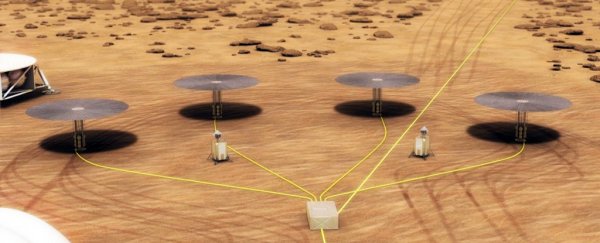Once we've figured out the logistics of getting people to Mars, there's the small matter of providing power for the first travellers to arrive.
NASA is already testing a compact nuclear power plant that could keep the lights on through the cold Martian nights.
With storage space at a premium and weight an issue for spacecraft journeying for millions of miles, taking fuel with us isn't really an option, which is why the Kilopower reactor could be so vital.
Various different models are being experimented with, from a 1-kilowatt version that can power up a toaster, to a 10-kilowatt reactor – around four or five of these would be enough to keep a small habitat up and running on Mars, according to the researchers involved.
"Mars is a very difficult environment for power systems, with less sunlight than Earth or the Moon, very cold night time temperatures, very interesting dust storms that can last weeks and months that engulf the entire planet," one of the team, NASA's Steve Jurczyk, told Will Dunham at Reuters.
"So Kilopower's compact size and robustness allows us to deliver multiple units on a single lander to the surface that provides tens of kilowatts of power."
As well as providing energy to purify water and produce oxygen on a Mars base, the reactors would also be used to make liquid oxygen and rocket fuel so the astronauts can travel back home again.
Looking like a metallic mushroom, the Kilopower uses a fission reaction on a solid metal block of fuel to produce heat, which is passed up into tubes filled with sodium. The resulting temperature differences are used to create electricity.
At the heart of the reactor is a Stirling engine, responsible for efficiently converting the heat produced by Kilopower into mechanical movement, and from there into electricity.
Part of the appeal of Kilopower is that nuclear fission can produce so much energy from so little fuel, a crucial requirement for keeping astronaut baggage allowances down. Just 0.45 kilograms (1 pound) of uranium can produce as much energy as 1.36 million kilograms (3 million pounds) of burnable coal.
While development is still at an early stage, with a lot of refinement and safety testing still to come, the initial results from Kilopower are promising. A full-power test is currently scheduled for March.
"The models have predicted very well what has happened, and operations have gone smoothly," Dave Poston, chief reactor designer at the Los Alamos National Laboratory in Nevada where the tests are taking place, told Reuters.
Once we've got the power sorted, we can start turning our attention to the other challenges of living on Mars – like the harsh and unforgiving environment.
Further down the line, Kilopower and similar technologies could help to get spacecraft further out to the edges of the Solar System, as well as helping us charge up gadgets and do some cooking when we reach our destinations.
"The reactor technology we are testing could be applicable to multiple NASA missions, and we ultimately hope that this is the first step for fission reactors to create a new paradigm of truly ambitious and inspiring space exploration," says Poston.
"Simplicity is essential to any first-of-a-kind engineering project – not necessarily the simplest design, but finding the simplest path through design, development, fabrication, safety and testing."
The researchers have put together a video explaining the technology which you can see below:
